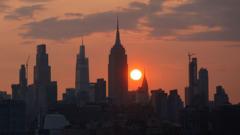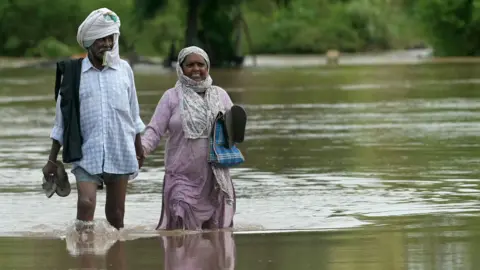Recent wildfires in Canada have prompted the New York State Department of Environmental Conservation (DEC) and Department of Health (DOH) to declare an air quality advisory for New York City and several nearby regions, including Long Island and the Adirondacks. The advisory comes with warnings that air quality levels are "unhealthy for sensitive groups," due to the haze streaming southward from Canada where tens of thousands have been forced to evacuate their homes.
As the air quality index (AQI) is expected to surpass 100 in many parts of New York and possibly reach 135, concerns escalate over health risks associated with breathing polluted air. This metric categorizes air quality based on pollution severity, with higher numbers indicating greater danger. Similar alerts have been previously issued across the U.S.; in mid-July, Chicago experienced a similar situation leading to additional health precautions for vulnerable populations.
The political ramifications of the smoke have prompted responses from Washington as well. Six U.S. Congress members have communicated their frustrations to the Canadian ambassador, asserting that the smoke is diminishing the summer experience for Americans.
At present, over 550 fires remain active in Canada, particularly in Manitoba, resulting in a significant area of land—approximately 6.1 million hectares—ravaged in the past year. May and June alone saw emergency evacuations of about 30,000 individuals from the provinces of Saskatchewan and Manitoba. Climate scientists are now drawing connections between the increasing frequency and severity of wildfires and climate change, particularly noting that Canada is warming at double the global average rate, with its Arctic regions heating at even higher rates.
As the air quality index (AQI) is expected to surpass 100 in many parts of New York and possibly reach 135, concerns escalate over health risks associated with breathing polluted air. This metric categorizes air quality based on pollution severity, with higher numbers indicating greater danger. Similar alerts have been previously issued across the U.S.; in mid-July, Chicago experienced a similar situation leading to additional health precautions for vulnerable populations.
The political ramifications of the smoke have prompted responses from Washington as well. Six U.S. Congress members have communicated their frustrations to the Canadian ambassador, asserting that the smoke is diminishing the summer experience for Americans.
At present, over 550 fires remain active in Canada, particularly in Manitoba, resulting in a significant area of land—approximately 6.1 million hectares—ravaged in the past year. May and June alone saw emergency evacuations of about 30,000 individuals from the provinces of Saskatchewan and Manitoba. Climate scientists are now drawing connections between the increasing frequency and severity of wildfires and climate change, particularly noting that Canada is warming at double the global average rate, with its Arctic regions heating at even higher rates.


















